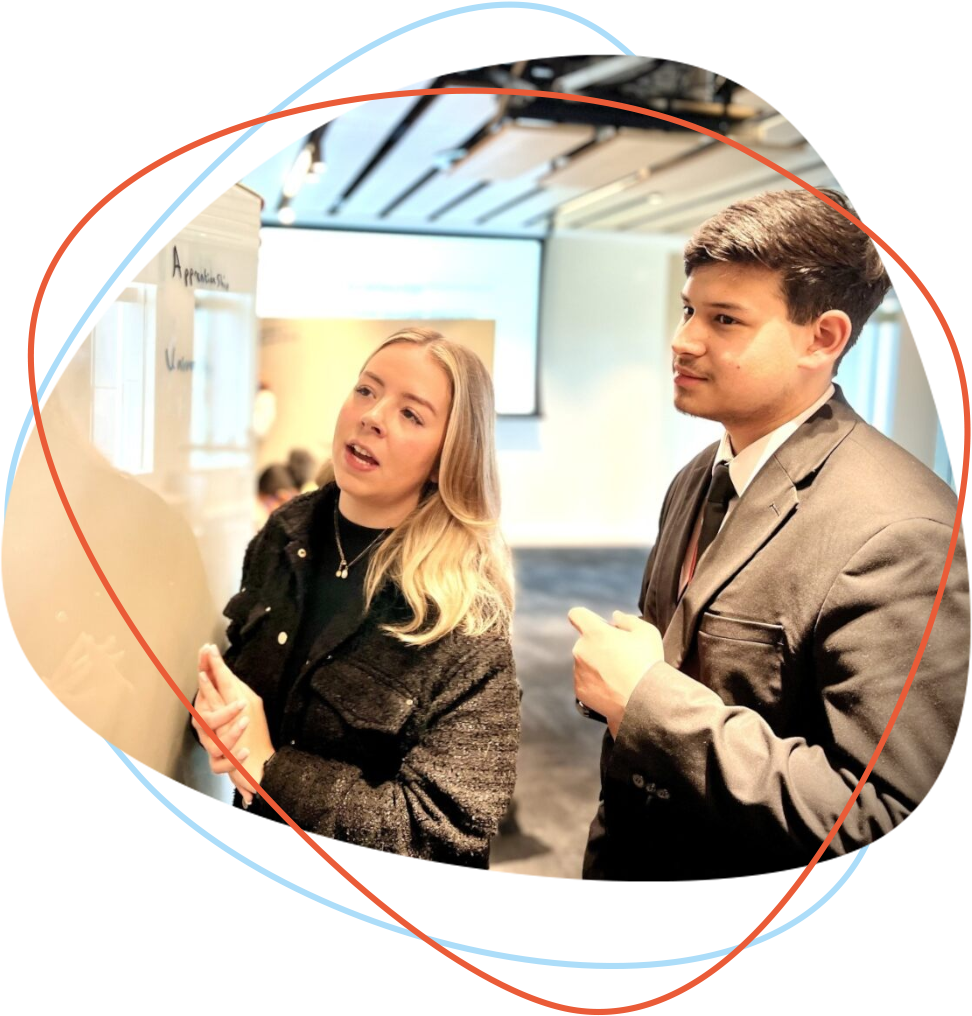It can sometimes feel difficult to be creative, think outside the box or find new ways of doing old things. Don’t worry. This is completely normal, and many people find it really tough.
Creativity doesn’t have to involve producing lots of new ideas, every single second of the day. It can simply be the small act of thinking about a different way to do something.
Creativity is a core skill that you probably use more often than you think and more importantly, it’s one that can be developed over time.
Why is creativity important?
Creativity can enhance other skills such as confidence, resilience, and communication, all of which are vital when at school, going for an interview, or starting a new job.
It’s a skill required for all industries, sectors and roles, even if you might not immediately think of them as ‘creative jobs’. From solicitors to nurses, financial advisors to marketing executives, all roles require a degree of creativity in order to help services grow and develop.
How can I use and develop my creative skills?
Don’t worry if you don’t consider yourself to be ‘creative’.
The following tips are simple to follow and designed to support everyone to develop their creative skills – not just those amazing at art or building models from scratch.
Above all else, remember that creativity isn’t something that should feel forced. If you put yourself under too much pressure to be creative, you can suffer from a ‘creative block’ and stifle your ideas. So, make sure to have fun and relax into the creative process.
Make everyday activities creative
Don’t be fooled. The small everyday tasks that you think are boring could be your next outlet for creativity.
Daily tasks like organising your laundry, cooking, doing a school project, or cleaning your room could all be things that have creative potential.
Change your attitude towards them and let them fill the creative hole you might be experiencing.
For example, look at your wardrobe and work out if there is a better way to organise it. There are loads of online tutorials on how to do this! Coordinate by colour, arrange by item, or file by material. The possibilities are endless.
You might be wondering how something like this could really impact your employability. Well, it can often be small and simple activities like this that can help you adopt a creative mindset and apply innovation to every task you do. For more information on how to improve your employability, click here.
Create a mood board
Don’t let your ideas and goals stick around inside your head or risk being forgotten about! Bring them to life on paper by creating a mood board.
This can be a really helpful way of presenting a creative vision to you and to others in a visual way. It’s often the first step on the journey to bringing an idea or goal to life.
Did you know: in the creative industries such as advertising, marketing or branding, employees regularly use mood boards to come up with new ideas or products?
So how do you start your own mood board?
-
Start by writing the idea or goal somewhere on the page or board.
-
Find images, quotes, articles, materials and descriptive words that inspire you and are reflective of your idea or goal.
-
Start putting your mood board together by sticking the different images down on the board.
-
Play around with the different ways you could organise the mood board. Try to experiment with different layouts. It doesn’t need to be rushed and you can always come back to it when you want.
The more creative you allow yourself to be with your mood board, the more it can positively influence your mindset. You can also use other ways to present your mood board beyond paper. Technology now allows you to create mood boards easily on websites such as Pinterest and Milanote.
Making one mood board might even spark your imagination further. That’s one of the great advantages of a mood board, they’re stimulating and keep your creative ideas flowing.
Keep your imagination alive
Using your imagination is a key part of sparking your creativity.
Make time in your day to enjoy the things which can stimulate your creative thinking. This could be anything including having a conversation with a friend or family member, watching a TV show or film, or reading a new book.
By keeping your imagination active, you continue to allow yourself to be challenged. Your imagination can push your creativity further, help you rethink things you previously thought might not have been possible, and increase your own aspirations.
Have a camera to hand
If you have one, it’s a great idea to try to keep your camera (or phone) to hand. It’s one of the best ways to document your thoughts and ideas. You never know when you’re going to see something that sparks your imagination and creativity!
Be aware of your surroundings and, when you can, try to use your camera to explore things that make you curious. Take as many photos as you can, and don’t limit yourself. Use your camera’s features to find new and unconventional ways of taking a photo and try to be more experimental with what you capture.
Don’t worry if you don’t feel that you have the photography skills to do this. This is not about being an expert at photography. It is about helping you to keep your imagination active and to become more observant of the world around you. Using your camera can challenge your perceptions and help you see things in a new way.
Don’t delete photos if you don’t immediately like them; something in that photo could lead to a new idea in the future.
Repurpose items
By reconsidering what’s around you and finding a new purpose for things, you can boost your imagination and become more innovative with your ideas.
It’s easy to get started. There are a range of different online tutorials out there which can help you. These tutorials are great if you are a beginner and not sure where to start. For instance, if you want to find out how the ingredients in your kitchen could create your next face mask, an online tutorial can help you understand what to do and help you think outside the box.
Being creative in this way will often take practice and can involve a lot of trial and error. If things don’t work out how you initially planned, look at what went well in addition to what you could have done differently.
We all learn through trying new things and you might need to try a few times before you feel happy with the end result.
That’s all part of learning and developing the skills you have.
Nobody expects your creations to be perfect, but you can still enjoy the process. In the long run, it will strengthen your resilience whilst also developing a more positive attitude towards problem solving and dealing with the unexpected.
Make video diaries
The things we are seeing and experiencing right now might be a distant memory in a few years’ time.
Use your creative skills to document your experiences by making a video diary or a v-log. This can be a place for you to express your ideas and talk about things that are currently keeping you occupied.
Use the creative skills you are developing to make it the best it can be. You could try using different editing techniques with each diary entry or try different ways of filming the diary each day i.e., a new room, outdoors, a different angle.
Don’t worry about having fancy equipment either. Most phones these days can record and edit videos. You can also complete this exercise as a journal, if you'd prefer, to help you keep positive during difficult times.
So, what now?
The activities below have all been designed to help you get fully ready to take your next steps - whatever pathway you choose to take. Each set of activities ranges from a short activity which should take no more than 30 minutes, through to portfolio activities, which are longer, project-based tasks. The more time you spend on each activity, the more you'll get out of it, but you should be able to find something each week to fit into your schedule.
Why not start with the short activity first and then work your way through the remaining activities until you’ve completed them all?
Short activity
Pick an independent business, and research it online.
- List examples of creativity that you find - everything from colour choices on the website, to interesting products and strategies they are using to promote themselves.
- Why do you think they’ve chosen the designs they have?
- What does it tell you about the message of the business?
Main activity
Create a mood board for a future aspiration of yours.
This could be school-related, professionally for what job you would like to do, an industry you want to work in, something personal to you.
- Compile what excites you and motivates you to want to achieve that aspiration.
There are no rules or limits to what you can do – be as creative as you would like.
For example, include pictures, quotes, crafts, graphics or objects to your mood board. It is your story to tell.
Portfolio
Think of a brand that you know well, that you think could do with a rebrand.
-
Take some time to think about how that could look, including a new colour scheme, logo, tagline, mission statement.
-
Write about the choices and changes you have made and why, what makes your ideas more appealing for clients or customers?
If you have time, put some of your recommended changes into practice and design a pitch for the rebrand.
PSHE lesson
Think of a fictional business that is struggling. For example, a bakery that can no longer afford to rent its shop and have a physical presence on the high street.
- Split the class into groups and ask them to think of creative ways to overcome the challenges faced by the business.
For example, they may create a social media campaign to promote an offer encouraging new customers into the store, or a crowdfunding page to generate funds to buy a mobile baking unit.
- Students should explain why their creative idea would generate new business and enable the business to thrive.


